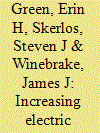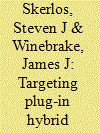| Srl | Item |
| 1 |
ID:
111346


|
|
|
|
|
| Publication |
2012.
|
| Summary/Abstract |
The recently amended U.S. Corporate Average Fuel Economy (CAFE) standards determine fuel-economy targets based on the footprint (wheelbase by track width) of vehicles such that larger vehicles have lower fuel-economy targets. This paper considers whether these standards create an incentive for firms to increase vehicle size by presenting an oligopolistic-equilibrium model in which automotive firms can modify vehicle dimensions, implement fuel-saving technology features, and trade off acceleration performance and fuel economy. Wide ranges of scenarios for consumer preferences are considered. Results suggest that the footprint-based CAFE standards create an incentive to increase vehicle size except when consumer preference for vehicle size is near its lower bound and preference for acceleration is near its upper bound. In all other simulations, the sales-weighted average vehicle size increases by 2-32%, undermining gains in fuel economy by 1-4 mpg (0.6-1.7 km/L). Carbon-dioxide emissions from these vehicles are 5-15% higher as a result (4.69×1011-5.17×1011 kg for one year of produced vehicles compared to 4.47×1011 kg with no size changes), which is equivalent to adding 3-10 coal-fired power plants to the electricity grid each year. Furthermore, results suggest that the incentive is larger for light trucks than for passenger cars, which could increase traffic safety risks.
|
|
|
|
|
|
|
|
|
|
|
|
|
|
|
|
| 2 |
ID:
127282


|
|
|
|
|
| Publication |
2014.
|
| Summary/Abstract |
Plug-In Electric Vehicles (PEVs) provide an opportunity for reducing energy use and emissions in the transportation sector. Currently, a number of federal policies are in place to incentivize deployment of PEVs to mainstream consumers with demographics and vehicle attribute preferences most common to today's new vehicle purchasers. This article argues that policies intending to give PEVs a foothold in the market should not focus on mainstream consumers and should instead focus on niche markets-specifically carsharing and postal fleets-and early adopters including green consumers. Two arguments can be made in support of eliminating the mainstream market bias of current policies toward a policy of cultivating niche markets. The first is efficiency: so far PEV policies featuring a mainstream market bias have proven to be inefficient and costly. The second is effectiveness: it is becoming increasingly evident that PEV policies would be more effective in achieving potential societal benefits if they focused on early adopters and niche markets using such approaches as strategic niche management, accessible loans and financing, and appropriately targeted incentives. PEV policies focused on early adopters and niche markets would create complementary system effects that will lead to increased PEV market penetration and realization of intended societal benefits.
|
|
|
|
|
|
|
|
|
|
|
|
|
|
|
|
| 3 |
ID:
094208


|
|
|
|
|
| Publication |
2010.
|
| Summary/Abstract |
In 2009 the U.S. federal government enacted tax credits aimed at encouraging consumers to purchase plug-in hybrid electric vehicles (PHEVs). These tax credits are available to all consumers equally and therefore do not account for the variability in social benefits associated with PHEV operation in different parts of the country. The tax credits also do not consider variability in consumer income. This paper discusses why the PHEV subsidy policy would have higher social benefits at equal or less cost if the tax credits were offered at different levels depending on consumer income and the location of purchase. Quantification of these higher social benefits and related policy proposals are left for future work.
|
|
|
|
|
|
|
|
|
|
|
|
|
|
|
|